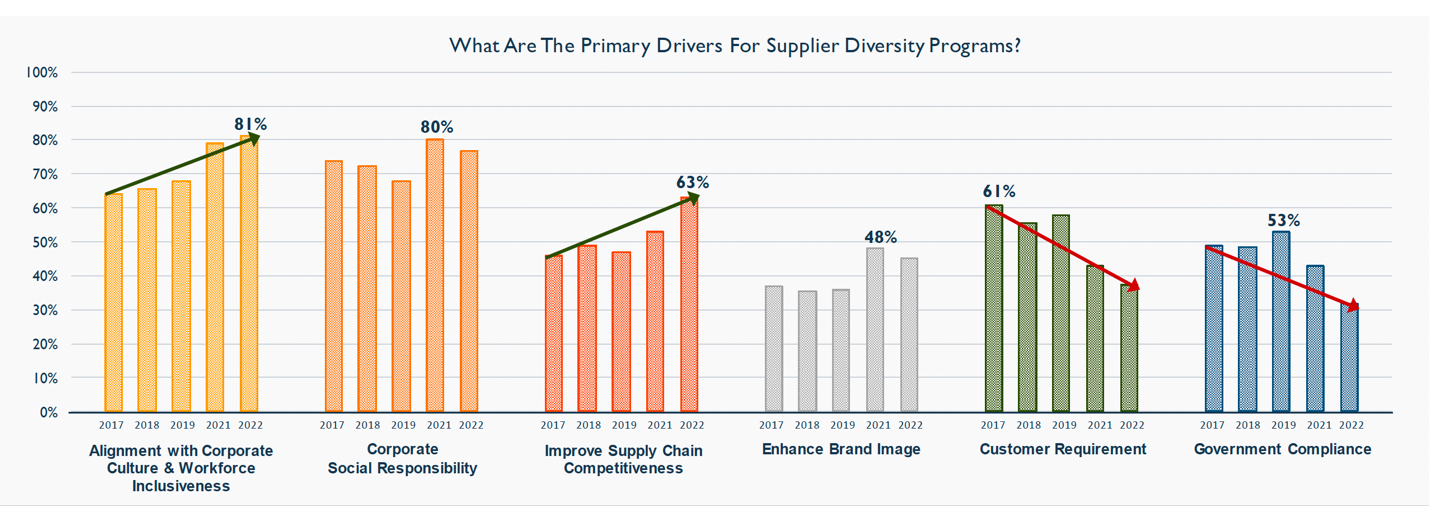The annual release of the State of Supplier Diversity Report offers endless opportunities for analysis and interpretation. With so much new data to compare to years’ worth of surveys, the only limits are time and imagination. When all the independent data points from the survey are brought together, compared to prior years, and considered carefully, a story begins to emerge.
I can vouch for the thought and debate that are invested in bringing each year’s story into focus. This is my second year participating in the development of the report, two years that marked notable shifts in the supplier diversity movement as a whole.
The story revealed by the 2022 data contains good news as well as early warning signs for some shifts that seem to be in progress. In this series of blog posts, we will walk through some of the most interesting findings, sharing possible interpretations as well as recommendations for action.
Key Finding #1: Systemic Cultural Wins for the Supplier Diversity Movement
Why do companies invest in supplier diversity? Is it because they believe in the opportunity it represents, or are they simply complying with the requirements of customers and regulators?
In 2022, we see clear evidence that the third-party requirements of the past are giving way to proactive, internally driven choice. Companies are committed to backing their supplier diversity program because it aligns with their corporate culture and workforce inclusion efforts. They see the benefits for employees as well as their customers.
supplier.io asked, “What are the primary drivers for your supplier diversity program?” Respondents were able to make multiple selections, but the results are quite clear. Companies are choosing supplier diversity for the value it drives rather than the requirements it satisfies.
Eighty-one percent of respondents indicated that alignment with corporate culture and workforce inclusiveness serves as a primary driver of their supplier diversity program, with corporate social responsibility as a close second.
At the same time, the motivational role that customer requirements and government compliance play has reduced markedly year over year — a downward trend that began in 2019.
We know from other data included in the report that Tier 2 supplier diversity programs, while still growing, are alive and well. From this, we can conclude that customer requirements for supplier diversity data still exist, but they now serve as a validation of the decision to invest in diversity rather than a primary reason to have a program. This suggests that supplier diversity programs will continue to enjoy high levels of support rather than being subject to the changing priorities of third parties.
Key Measures for Supplier Diversity Program Success
Brand reputation continues to be a top measure of how successful a supplier diversity program is with 54 percent of respondents using this metric, but employee opinions are in second place with 40 percent. This is a critical differentiator in a tight and competitive talent market, and one that should pay dividends in years to come.
Fifty-four percent of respondents believe that supplier diversity has had a “‘significant impact”’ on their company. When we combine this group with those who indicated supplier diversity had a “‘measurable impact,”’ we find that an overwhelming 78 percent are aware of the positive returns.
Perhaps this is one reason why executive-level participation continues to be robust. The 2022 survey found that executive level engagement remains high, with 61 percent of CEOs engaging in supplier diversity programs and 31 percent of Boards doing the same.
Stay Tuned for More Supplier Diversity Program Insights
This is an exciting and affirming time for supplier diversity managers and advocates, but there is work to be done as well. Interestingly, some of the most pressing items to be addressed find their roots in the organizational embrace of supplier diversity we currently enjoy.
In the next post in this series, we will consider the changes being seen in accountability and program measurement as well as their connection to the successful future of the supplier diversity movement.




